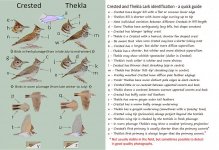John Cantelo
Well-known member
After a lapse of more than a decade, I've been trying to get back into drawing birds over the last few weeks. I find it's not only a great way to get ID features into my brain but also terrific therapy for not being able to get out birding as much as I'd like these days. Being a glutton for punishment one of my first 'projects' has been to have a crack at illustrating and summarising the thorny problem of Crested vs Thekla Lark ID. It's come up a number of times here so I hope it may prove useful. Personally, of all the features, I find bill shape most useful. I've deliberately tried to illustrate the 'extremes' so be warned they can look more similar than depicted here. Although guides tell us that longer billed Theklas are found in North Africa rather than Iberia, I sometimes see Theklas with longer bills than the birds I habitually see in Cadiz province. I know too that more experienced birders see larks in the field that they struggle to asign to either species than is commonly acknowledged! Some consider them hybrids, but I'm told that DNA evidence does not support this thesis. Comments welcome, but be kind I'm a little rusty.








